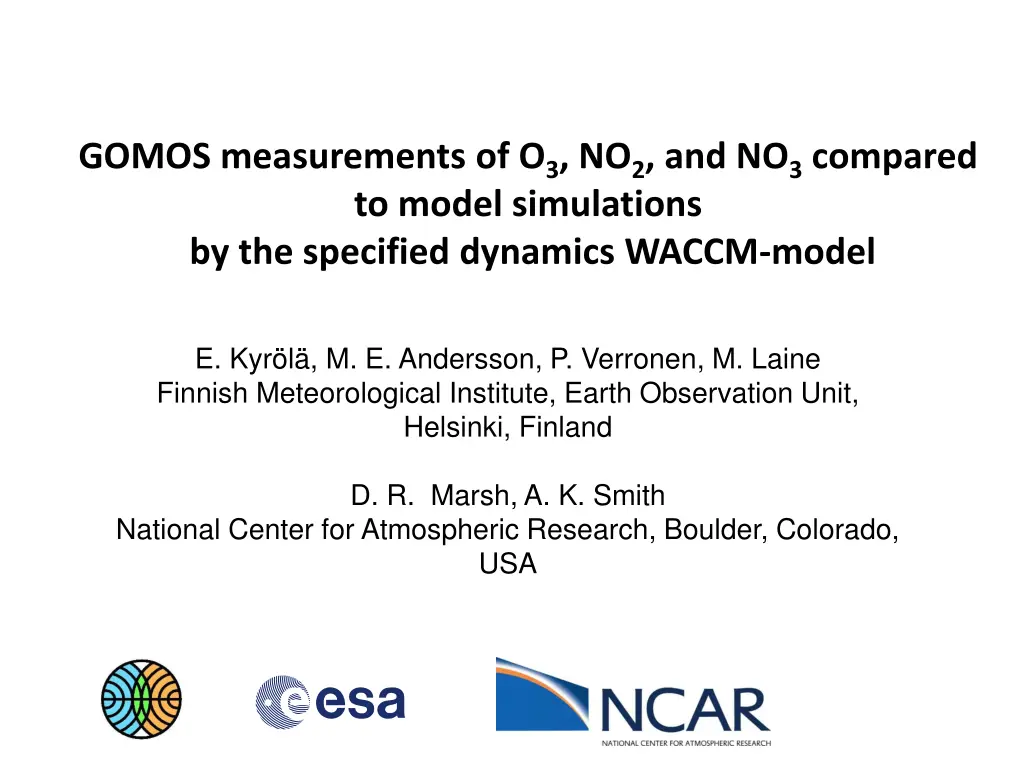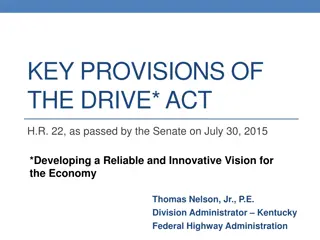
Comparing WACCM Model Simulations to GOMOS Measurements of Ozone and Nitrogen Compounds
Explore the comparison between WACCM model simulations and GOMOS measurements of O3, NO2, and NO3 by E. Kyrl, M. E. Andersson, P. Verronen, and M. Laine. Understand the methodology, challenges, and findings in assessing the accuracy of atmospheric models based on real-world data. Discover the insights derived from the analysis conducted by researchers from the Finnish Meteorological Institute and the National Center for Atmospheric Research.
Download Presentation

Please find below an Image/Link to download the presentation.
The content on the website is provided AS IS for your information and personal use only. It may not be sold, licensed, or shared on other websites without obtaining consent from the author. If you encounter any issues during the download, it is possible that the publisher has removed the file from their server.
You are allowed to download the files provided on this website for personal or commercial use, subject to the condition that they are used lawfully. All files are the property of their respective owners.
The content on the website is provided AS IS for your information and personal use only. It may not be sold, licensed, or shared on other websites without obtaining consent from the author.
E N D
Presentation Transcript
GOMOS measurements of O3, NO2, and NO3 compared to model simulations by the specified dynamics WACCM-model E. Kyr l , M. E. Andersson, P. Verronen, M. Laine Finnish Meteorological Institute, Earth Observation Unit, Helsinki, Finland D. R. Marsh, A. K. Smith National Center for Atmospheric Research, Boulder, Colorado, USA
Motivation Models are widely used to analyse and predict the state of atmosphere. How close are model simulations to measurements? Outline WACCM and GOMOS Method WACCM-GOMOS O3, NO2 ,NO3 WACCM-D in Arctic Summary 2
Community Earth System Model (CESM) WACCM validated version 4 (CESM 1.0.5) Specified dynamics mode (SD): MERRA up to 50 km Enhanced by Medium Energy Electrons (MEE): 30-300 keV WACCM A T M O S P H E R E From surface up to 150 km, 88 levels Neutral chemistry model for the MA Ion chemistry in the MLT Auroral processes, SPEs EUV and non-LTE long wave radiation Imposed QBO, based on winds Volcanic aerosol heating Gravity wave drag deposition Molecular diff. and constituent separation LAND COUPLER SEA ICE OCEAN 3
GOMOS2002-2012 Iref(! ) Iocc(! ) 880 000 measurements 450 000 night occs. 430 000 day occs. (not used here) +self-calibration +coverage (180 stars) +vertical resolution +night -S/N low -GOMOS CCD: sensitive to protons Sirius, the brightest star in the sky 4
Method Because of non-uniform distribution (time-space) of GOMOS measurements a climatological comparison leads to problems. Instead we compare every GOMOS (night) profile to the nearest latitude-longitude-time cell of WACMM. This eliminates the sampling problem. Latitude difference <0.9 deg., longitudinal difference <1.25 deg. and time difference <15 min. Excellent co-location. Comparisons in mixing ratio on pressure grid of WACCM. GOMOS number densities transformed by the WACCM neutral density. GOMOS altitudes linked to WACCM grid by WACCM geopotential. 5
WACCM vs GOMOS ozone 2002-2011 Sirius occultations 40S-60S (September) GOMOS WACCM 7
<WACCM-GOMOS>/<GOMOS> (%): O3 in Stratosphere Gomos required range: 20-100 km GOMOS well-know positive bias problem in UTLS (Sofieva, AMT, 2016)8
(WACCM-GOMOS)/GOMOS (%): O3 in Mesosphere Gomos required range: 20-100 km 9
WACCM vs GOMOS NO2 2002-2011 Sirius occultations 40S-60S (September) 10
<WACCM-GOMOS>/<GOMOS> (%): NO2 in Stratosphere Gomos required range: 25-50 km 11
WACCM vs GOMOS NO3 2002-2011 Sirius occultations 40S-60S (September) 12
<WACCM-GOMOS>/<GOMOS> (%): NO3 in Stratosphere 13
WACCM-D: Halloween event in Arctic: O3 and NO2 WACCM-D: Ionospheric D-region chemistry: 307 reactions, 20 positive ions, 21 negative ions See Verronen et al., JAME, 2016 Andersson et al., JGRD, 2016 14
SD-WACCM-D versions Verronen et al., JAMES, 2016 Andersson et al., JGR, 2016 WACCM-D: D-region ion chemistry: 307 new reactions, 22+20 ions BASIC: SD-WACCM (v. 4) MEE: SD-WACCM + medium energy electrons (POES) D-MEE: SD-WACCM+ D ion chemistry + MEE (POES) 15
2003 Halloween storm: O3 November 15-30, 70N-90N Similar to the mid-latitude result 16
2003 Halloween storm: NO2 November 15-30, 70N-90N 17
Strong mesospheric descent: NO2 25.1.-5.2. 2004, 75N-85 N 18
Summary GOMOS and WACCM O3 compare well in stratosphere. WACCM values are 2-6 % smaller than GOMOS. In the mesosphere WACCM fails to produce the strength of the second ozone peak. GOMOS and WACCM NO2 compare well in the stratosphere outside the polar areas. GOMOS is 5-15 % smaller than WACCM. GOMOS and WACCM NO3 compare well in the stratosphere. GOMOS is 0-20 % smaller than WACCM. In the polar areas standard WACCM fails to reach the elevated NO2 amounts. WACCM-D provides better NO2 comparisons during particle events in polar regions. During the strong downdraft event January 2004 the huge NO2 values are not simulated by WACCM. 19


















